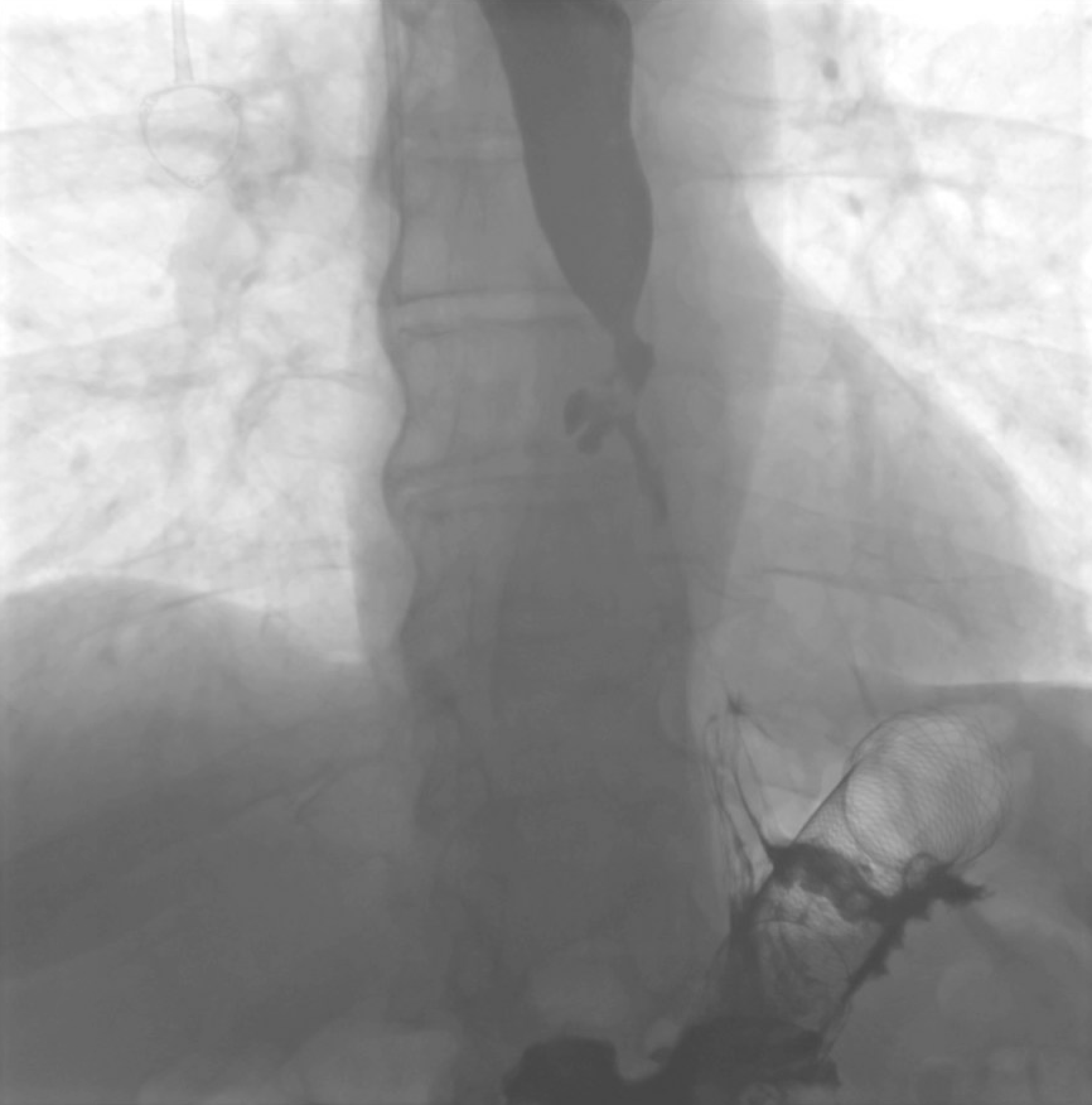Tuesday Poster Session
Category: Esophagus
P5002 - CryoBalloon for Esophageal Benign Stricture
Tuesday, October 28, 2025
10:30 AM - 4:00 PM PDT
Location: Exhibit Hall

Varun Angajala, MS, MD (he/him/his)
Boston University
Boston, MA
Presenting Author(s)
Varun Angajala, MS, MD1, Adam Welu, MD1, Hiroshi Mashimo, MD, PhD2
1Boston University, Boston, MA; 2Harvard University, Boston, MA
Introduction: We present a case of cryoablation with CryoBalloon and intralesional steroid injection for management of benign esophageal stricture in a patient with prior malignancy, refractory to serial dilation and stenting.
Case Description/
Methods: This is a 63-year-old male with history of obstructive sleep apnea, atrial fibrillation, heart failure, and GERD with long-segment Barrett’s esophagus who was diagnosed in 2018 with esophageal adenocarcinoma metastatic to lung, liver, and bone. Deemed a poor surgical candidate, he underwent palliative chemoradiation, G-tube placement, and esophageal stenting. The patient was referred to our center for removal of the stent which had migrated to the stomach and could not be extracted after several attempts, resulting in hematemesis. A double-channel therapeutic endoscope with a snare, rat-tooth forceps, and overtube were required for retrieval, while protecting the mucosa from metal edges which were frayed from prior removal attempts. Serial cryoablations ensued, and by 2020 he had no residual cancer. Despite a tight stricture, a properly-seated stent again migrated to the stomach and was extracted. Serial balloon dilations (sometimes requiring ultrathin endoscope for guidewire placement) were performed from 2021 to 2023.
In 2024, he underwent cryoablation with C2 CryoBalloon (Pentax Medical, Tokyo, Japan) ablation and triamcinolone injection. Post-procedure, he experienced nausea and chest pain, but imaging ruled out perforation and findings were attributed to post-cryoablation swelling and diverticulum. He recovered well and underwent a successful CRE 8-9-10 dilation after 4 months. Endoscopic biopsies again showed no malignancy. He is scheduled for reassessment and possible re-dilation.
Discussion: Cryoablation has established uses for palliation of malignant esophageal disease and ablation of dysplastic Barrett’s esophagus. The role of cryoablation in managing benign esophageal strictures is still emerging. The concept of “cryo-dilation,” first described in 2019, involves applying cryoablation spray immediately before balloon dilation. Ours is the first case of cryoablation using CryoBalloon for treatment of a benign esophageal stricture. Additionally, our case highlights the serious risks associated with esophageal stent migration in both malignant and benign settings. Our patient required transfer to our facility after multiple failed retrieval attempts, underscoring the importance of alternative therapies like cryoablation.

Figure: Figure 1. Barium esophagogram demonstrating tight esophageal stricture and migrated metal stent in the stomach.

Figure: Figure 2A. Upper esophageal stricture during application of cryoablation using C2 CryoBalloon. B. Upper esophageal stricture after cryoablation. C. Esophageal diverticulum located within stricture in mid-esophagus. D. Barrett's esophagus in mid- to distal esophagus.
Disclosures:
Varun Angajala indicated no relevant financial relationships.
Adam Welu indicated no relevant financial relationships.
Hiroshi Mashimo indicated no relevant financial relationships.
Varun Angajala, MS, MD1, Adam Welu, MD1, Hiroshi Mashimo, MD, PhD2. P5002 - CryoBalloon for Esophageal Benign Stricture, ACG 2025 Annual Scientific Meeting Abstracts. Phoenix, AZ: American College of Gastroenterology.
1Boston University, Boston, MA; 2Harvard University, Boston, MA
Introduction: We present a case of cryoablation with CryoBalloon and intralesional steroid injection for management of benign esophageal stricture in a patient with prior malignancy, refractory to serial dilation and stenting.
Case Description/
Methods: This is a 63-year-old male with history of obstructive sleep apnea, atrial fibrillation, heart failure, and GERD with long-segment Barrett’s esophagus who was diagnosed in 2018 with esophageal adenocarcinoma metastatic to lung, liver, and bone. Deemed a poor surgical candidate, he underwent palliative chemoradiation, G-tube placement, and esophageal stenting. The patient was referred to our center for removal of the stent which had migrated to the stomach and could not be extracted after several attempts, resulting in hematemesis. A double-channel therapeutic endoscope with a snare, rat-tooth forceps, and overtube were required for retrieval, while protecting the mucosa from metal edges which were frayed from prior removal attempts. Serial cryoablations ensued, and by 2020 he had no residual cancer. Despite a tight stricture, a properly-seated stent again migrated to the stomach and was extracted. Serial balloon dilations (sometimes requiring ultrathin endoscope for guidewire placement) were performed from 2021 to 2023.
In 2024, he underwent cryoablation with C2 CryoBalloon (Pentax Medical, Tokyo, Japan) ablation and triamcinolone injection. Post-procedure, he experienced nausea and chest pain, but imaging ruled out perforation and findings were attributed to post-cryoablation swelling and diverticulum. He recovered well and underwent a successful CRE 8-9-10 dilation after 4 months. Endoscopic biopsies again showed no malignancy. He is scheduled for reassessment and possible re-dilation.
Discussion: Cryoablation has established uses for palliation of malignant esophageal disease and ablation of dysplastic Barrett’s esophagus. The role of cryoablation in managing benign esophageal strictures is still emerging. The concept of “cryo-dilation,” first described in 2019, involves applying cryoablation spray immediately before balloon dilation. Ours is the first case of cryoablation using CryoBalloon for treatment of a benign esophageal stricture. Additionally, our case highlights the serious risks associated with esophageal stent migration in both malignant and benign settings. Our patient required transfer to our facility after multiple failed retrieval attempts, underscoring the importance of alternative therapies like cryoablation.

Figure: Figure 1. Barium esophagogram demonstrating tight esophageal stricture and migrated metal stent in the stomach.

Figure: Figure 2A. Upper esophageal stricture during application of cryoablation using C2 CryoBalloon. B. Upper esophageal stricture after cryoablation. C. Esophageal diverticulum located within stricture in mid-esophagus. D. Barrett's esophagus in mid- to distal esophagus.
Disclosures:
Varun Angajala indicated no relevant financial relationships.
Adam Welu indicated no relevant financial relationships.
Hiroshi Mashimo indicated no relevant financial relationships.
Varun Angajala, MS, MD1, Adam Welu, MD1, Hiroshi Mashimo, MD, PhD2. P5002 - CryoBalloon for Esophageal Benign Stricture, ACG 2025 Annual Scientific Meeting Abstracts. Phoenix, AZ: American College of Gastroenterology.
